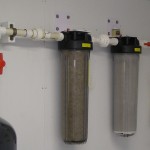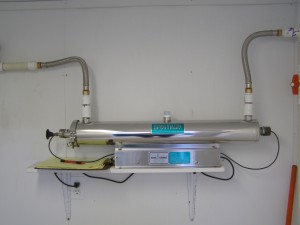Treatment of the water after the storage and before use is critical for both health of the users and maintenance of the system. The level of treatment will depend of the intended use of the water. For example, water used for landscape drip irrigation would not need the same level of treatment as water used for potable indoor purposes. In any case, we recommend a multi-barrier approach where more than one method of treatment are used to maximize effectiveness. For example, a common treatment-train for potable water in rural Texas is a set of cartridge filters followed by a ultraviolet light. Below are the different types of water treatment available.
Filtration
 Filtration is similar to screening but on a smaller scale. There are various levels of filtration, and they are measured on a “micron” level. This measures the diameter of a particle that would be blocked by the filter. For example, a 5-micron filter would block particles in the water that are 5 microns or larger. (a micron is one-millionth of a meter). Filters can remove microorganisms, sediment, metals, and other organic matter. If larger sized filters are used, small microorganisms, such as bacteria can pass through, so a disinfection method is needed (explained next). It is important that they are checked and changed on a regular basis so that they maintain their effectiveness.
Filtration is similar to screening but on a smaller scale. There are various levels of filtration, and they are measured on a “micron” level. This measures the diameter of a particle that would be blocked by the filter. For example, a 5-micron filter would block particles in the water that are 5 microns or larger. (a micron is one-millionth of a meter). Filters can remove microorganisms, sediment, metals, and other organic matter. If larger sized filters are used, small microorganisms, such as bacteria can pass through, so a disinfection method is needed (explained next). It is important that they are checked and changed on a regular basis so that they maintain their effectiveness.
Disinfection
The goal of disinfection is to destroy the microbiological organisms that have the potential to cause illness or harm. Some of the smaller microorganisms, such as bacteria, may pass through large cartridge filters so they must be targeted with disinfection. Three disinfection methods common to RWH systems are chlorination, ultraviolet light (UV), and ozonation.
Chlorination uses the chemical of chlorine in either dry, liquid, or gas to kill microorganisms. It is very effective with viruses and bacteria. An advantage to chlorine is that is leaves a residual so that your entire distribution system remains disinfected. However, using chlorine can be dangerous, so it’s important to follow manufacturer’s guidelines. Only use chlorine that is approved for potable water use (standard ANSI/NSF 60). For more information see this guidebook by the TCEQ.
 UV light is a common disinfection method used by Texas residents. The device works by sending water through a tube that contains the UV bulb (see picture on left). The light disrupts the DNA of microorganisms so that they can’t reproduce. There are a Class A and Class B UV light. The Class A light is rated to destroy pathogens and is required to have an alarm to alert users if the device is not working. A Class B light cannot be used as a sole method of disinfection but helps to polish water that has already been treated. An important point to keep in mind is that UV lights are most effective when the water is clear. Any sediment in the water can block the pathogens from the light. This is why have the filtration BEFORE the UV light is so critical. The UV light is harmful to look at directly, so use approved safety glasses when maintaining the device.
UV light is a common disinfection method used by Texas residents. The device works by sending water through a tube that contains the UV bulb (see picture on left). The light disrupts the DNA of microorganisms so that they can’t reproduce. There are a Class A and Class B UV light. The Class A light is rated to destroy pathogens and is required to have an alarm to alert users if the device is not working. A Class B light cannot be used as a sole method of disinfection but helps to polish water that has already been treated. An important point to keep in mind is that UV lights are most effective when the water is clear. Any sediment in the water can block the pathogens from the light. This is why have the filtration BEFORE the UV light is so critical. The UV light is harmful to look at directly, so use approved safety glasses when maintaining the device.
Ozonation
Ozonation disinfects by introducing ozone gas to the water. It is usually done at the point where water is used in the distribution system or in the storage tank. It is a colorless gas that disinfects, oxidizes, deodorizes, and decolorizes. Ozone gas is toxic and installation and maintenance of this type of system must be done by a licensed professional.
Adsorption
Adsorption uses activated carbon (charcoal filters) to bind to harmful contaminants, such as VOCs. These are the types of filters commonly used on faucets. They can also be used to remove chlorine from water used for disinfection.